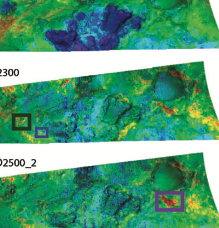Link to online paper: http://www.liebertpub.com/doi/10.1089/ast.2016.1606
Abstract
Low-temperature serpentinization is a critical process with respect to Earth’s habitability and the Solar System. Exothermic serpentinization reactions commonly produce hydrogen as a direct by-product and typically produce short-chained organic compounds indirectly. Here, we present the spectral and mineralogical variability in rocks from the serpentine-driven Lost City Hydrothermal Field on Earth and the olivine-rich region of Nili Fossae on Mars. Near- and thermal-infrared spectral measurements were made from a suite of Lost City rocks at wavelengths similar to those for instruments collecting measurements of the martian surface. Results from Lost City show a spectrally distinguishable suite of Mg-rich serpentine, Ca carbonates, talc, and amphibole minerals. Aggregated detections of low-grade metamorphic minerals in rocks from Nili Fossae were mapped and yielded a previously undetected serpentine exposure in the region. Direct comparison of the two spectral suites indicates similar mineralogy at both Lost City and in the Noachian (4–3.7 Ga) bedrock of Nili Fossae, Mars. Based on mapping of these spectral phases, the implied mineralogical suite appears to be extensive across the region. These results suggest that serpentinization was once an active process, indicating that water and energy sources were available, as well as a means for prebiotic chemistry during a time period when life was first emerging on Earth. Although the mineralogical assemblages identified on Mars are unlikely to be directly analogous to rocks that underlie the Lost City Hydrothermal Field, related geochemical processes (and associated sources of biologically accessible energy) were once present in the subsurface, making Nili Fossae a compelling candidate for a once-habitable environment on Mars. Key Words: Mars—Habitability—Serpentinization—Analogue. Astrobiology 17, 1138–1160.
